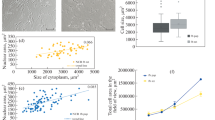Summary
Structural proteins of cultured neurofibromatosis (NF) tumor and skin cells were studied with reference to control skin fibroblasts. In polyacrylamide gel electrophoresis (PAGE)/fluorography the banding patterns of the cell lysates were markedly similar. NF tumor cells, however, produced a 60 kD band with a stronger and a 48 kD band with a lighter protein staining and metabolic labeling intensity. Furthermore, skin cells were also characterized by a 26 kD protein and the tumor cells by a 22 kD protein with high metabolic labeling intensity. Neuraminidase/galactose oxidase/NaB3H4-labeled NF skin and control skin cells possessed a 220 kD protein that was less intensively labeled in the tumor cells. The banding pattern of the skin cells was also characterized by a protein with slightly lower molecular weight (86 kD) than that of the tumor cell lysates (90 kD). In all cell lines studied indirect immunofluorescence stainings revealed bright arrays of vimentin type intermediary filaments but no desmin, cytokeratin, glial fibrillary acidic protein (GFAP), or neurofilament proteins. NF skin and control skin cells possessed well developed actin-containing bundles of microfilaments, while those of the tumor cells lacked a typical stress-fiber organization. The general morphology of the tumor cell cultures was also irregular. Transmission electron microscopy revealed no basic differences in the structure of intermediary filaments or microfilaments. The present data provide basic knowledge of neurofibromatosis skin and tumor cells and demonstrate that cultured cells originating from neurofibromas are defective in both their intracellular and extracellular organization.
Similar content being viewed by others
References
Badley, RA, Lloyd CW, Woods A, Carruthers L, Allock CA, Rees DA (1978) Mechanisms of cellular adhesion. III. Preparation and preliminary characterization of adhesions. Exp Cell Res 117:231–244
Barak SL, Yokum RR, Nothnagel EA, Webb WW (1980) Fluorescence staining of the actin cytoskeleton in living cells with 7-nitrobenz-2-oxa-1,3-diazole phallacidin. Proc Natl Acad Sci USA 74:34–38
Bennet GS, Fellini SA, Groop JM, Otto JJ, Bryan J, Holtzer H (1978) Differences among 100 Å filament subunits from different cell types. Proc Natl Acad Sci USA 75:4364–4368
Bignami A, Dahl D, Reuger DC (1980) Glial fibrillary acidic protein (GFA) in normal neural cells and in pathologic conditions. Adv Cell Neurobiol 7:285–310
Bonner WM, Laskey RA (1974) A film detection method for tritium-labelled proteins and nucleic acids in polyacrylamide gels. Eur J Biochem 46:83–88
Chen TR (1977) In situ detection of mycoplasma contamination in cell cultures by fluorescent Hoechst 33258 stain. Exp Cell Res 104:255–262
Dahl D, Bignami A (1977) Preparation of antisera to neurofilament protein from chicken brain and human sciatic nerve. J Comp Neurol 176:645–658
Franke WW, Schmid E, Osborn M, Weber K (1978) Different intermediate-sized filaments distinguished by immunofluorescence microscopy. Proc Natl Acad Sci USA 75:5034–5038
Gahmberg CG, Hakomori SI (1973) External labeling of cell surface galactose and galactosamine in glycolipid and glycoprotein of human erythrocytes. J Biol Chem 248:4311–4317
Krone W, Zorlein S, Mao R (1981) Cell culture studies on neurofibromatosis (von Recklinghausen). I. Comparative growth experiments with fibroblasts at high and low concentrations of fetal calf serum. Hum Genet 58:188–193
Krone W, Jirikowski G, Mühleck O, Kling H, Gall H (1983) Cell culture studies on neurofibromatosis (von Recklinghausen). II. Occurrence of glial cells in primary cultures of peripheral neurofibromatosis. Hum Genet 63:247–251
Lucky AW, Mahoney MJ, Barrnet RJ, Rosenberg LE (1975) Electron microscopy of human skin fibroblasts in situ during growth in culture. Exp Cell Res 92:383–393
Mollenhauer HH, Morre DJ (1978) Structural compartmentalization of the cytosol: zones of adhesion, cytoskeletal and intercisternal elements. Subcell Biochem 8:327–359
Nicolson GL (1980) Topographic display of cell surface components and their role in transmembrane signaling. Curr Top Dev Biol 131:305–338
O'Farrell PH (1975) High resolution two-dimensional electrophoresis of proteins. J Biol Chem 250:4007–4021
Peltonen J, Marttala T, Vihersaari T, Renvall S, Penttinen R (1981) Collagen synthesis in cells cultured from v. Recklinghausen's neurofibromatosis. Acta Neuropathol (Berl) 55: 183–187
Peltonen J, Aho H, Rinne UK, Penttinen R (1983) Neurofibromatosis tumor and skin cells in culture. Acta Neuropathol (Berl) 61:275–282
Rees DA, Lloyd CW, Thom D (1977) Control of grip and stick in cell adhesion through lateral relationship of membrane glycoproteins. Nature 267:124–128
Riccardi VM, Maragos VA (1980) Pathophysiology of neurofibromatosis. I. Resistance in vitro to nitrotyrosine as an expression of the mutation. In vitro 16:706–714
Riccardi VM, Maragos VA (1981) Characteristics of skin and tumor fibroblasts from neurofibromatosis patients. Adv Neurol 29:191–198
Schliwa M (1981) Proteins associated with cytoplasmic actin. Cell 25:587–590
Schneider EL (1979) Aging and cultured human skin fibroblasts. J Invest Dermatol 73:15–18
Vasiliev JM, Gelfrand IM (1981) Neoplastic and normal cells in culture. Cambridge University Press, Cambridge
Virtanen I, Lehto V-P, Lehtonen E, Vartio T, Stenman S (1981) Expression of intermediate filaments in cultured cells. J Cell Sci 50:45–63
Weihing RR (1979) The cytoskeleton and plasma membrane. Methods Achiev Exp Pathol 8:42–109
Zelkowitz M, Stambouly J (1980) Diminished epidermal growth factor binding by neurofibromatosis fibroblasts. Ann Neurol 8:296–299
Zelkowitz M (1981) Neurofibromatosis fibroblasts: abnormal growth and binding to epidermal growth factor. Adv Neurol 29:67–75
Author information
Authors and Affiliations
Additional information
Financially supported by grants (to JP) from the Research and Scienctific Foundation of Orion Oy Ltd. and by institutional grants from the Turku University Foundation and the Sigrid Jusélius Foundation.
Rights and permissions
About this article
Cite this article
Peltonen, J., Näntö-Salonen, K., Aho, H.J. et al. Neurofibromatosis tumor and skin cells in culture. Acta Neuropathol 63, 269–275 (1984). https://doi.org/10.1007/BF00687332
Received:
Accepted:
Issue Date:
DOI: https://doi.org/10.1007/BF00687332




